View in other NatureServe Network Field Guides
NatureServe
Montana
Utah
Wyoming
Idaho
Wisconsin
British Columbia
South Carolina
Yukon
California
New York
Dalmatian Toadflax - Linaria dalmatica
Other Names:
Linaria genistifolia ssp. dalmatica
State Rank Reason (see State Rank above)
Linaria dalmatica is a plant native to Eurasia and introduced worldwide (FNA 2006). A conservation status rank is not applicable (SNA) because the plant is an exotic (non-native) in Montana that is not a suitable target for conservation activities.
General Description
PLANTS: Short-lived perennial forbs that are rhizomatous from a caudex. Stems are erect, branched, and 40–80 cm tall. Plants are glabrous (no hairs), succulent, and waxy with a bluish to whitish cast. Sources: Lajeunesse in Sheley and Petroff 1999; Lesica et al. 2012.
LEAVES: Alternate on the stem. Blades are ovate, acute tipped, 2–5 cm long, sessile, and clasping around the stem.
INFLORESCENCE: A terminal bracteate raceme. Bright yellow flowers with orange centers and yellow spurs are snapdragon shaped and grow from the upper leaf nodes (leaf base).
Dalmatian Toadflax was named for the district of Dalmatia to where it is native in Eurasia (Alex 1959).
Phenology
Flowers develop in June through July with seed dispersal beginning in early July. Plant can continue to flower until winter arrives. Germination can occur in the fall, but primarily occurs the following April to May. Source: (Lajeunesse in Sheley and Petroff 1999).
Diagnostic Characteristics
Montana’s two exotic Toadflax are both rhizomatous with similar snapdragon type flowers, but are easily separated by their leaves. Hybrids between the species can be produced in the lab, but are not known to occur under natural conditions (Lajeunesse
in Sheley and Petroff 1999).
Linaria dalmatica leaves are ovate, less than 8 times as long as wide, and clasp around the stem.
Linaria vulgaris leaves are linear, more than 8 times as along as wide, and do not clasp the stem.
Narrow-leaf Dalmatian Toadflax or
Brown-leaved Toadflax (
Linaria genistifolia (L.) Mill.) is considered a subspecies of Broad-leaved Dalmatian Toadflax (
Linaria dalmatica (L.) Mill.). Narrow-leaved Dalmatian Toadflax was separated based on smaller flowers (1.5-2 cm long), on average narrower leaves, 1.5-4.5 cm by 2-10(12) mm, and leaves that do not strongly clasp the stem.
Species Range
Montana Range
Range Descriptions
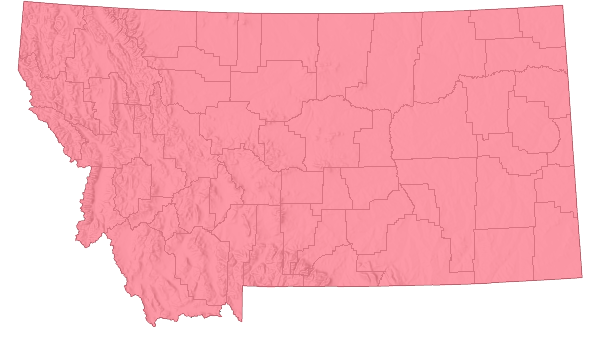
 Non-native
Non-native
Range Comments
Native to the Mediterranean region, Dalmatian Toadflax has been under cultivation for about 400 years in Europe (Lajeunesse in Sheley and Petroff 1999). Specifically, it is native to the district of Dalmatia which includes Croatia, Yugoslavia, Bosnia, Hercegovina, the islands in the Adriatic Sea and a mainland which lies entirely within the Dinaric Alps (Alex 1959). Around 1874 it was introduced into North American as a garden ornamental. It escaped establishing into farmyards, pastures, and rangelands. Infestations are more sporadic in the east (Lesica et al. 2012).
Adhikari et al. (2020) modeled the predicted future distribution of this and other weed species across the major road network in Montana under predicted future climate scenarios and found that area of predicted future habitat suitability is likely to decrease.
For maps and other distributional information on non-native species see:
Nonindigenous Aquatic Species Database from the U.S. Geological Survey
Invasive Species Habitat Tool (INHABIT) from the U.S. Geological Survey
Invasive Species Compendium from the Centre for Agriculture and Bioscience International (CABI)
EDDMapS Species Information EDDMapS Species Information
Observations in Montana Natural Heritage Program Database
Number of Observations: 21856
(Click on the following maps and charts to see full sized version)
Map Help and Descriptions
Relative Density
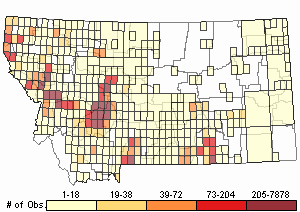
Recency
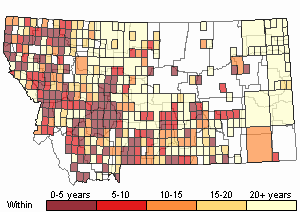

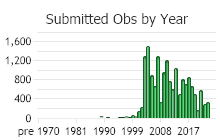
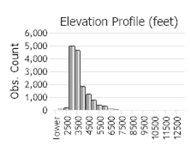 (Observations spanning multiple months or years are excluded from time charts)
(Observations spanning multiple months or years are excluded from time charts)
Habitat
Fields, roadsides, grasslands, often in stony soil; plains, valleys (Lesica et al. 2012).
Ecology
Dalmatian Toadflax has high genetic variability which allows it to occupy a wide range of conditions (Lajeunesse
in Sheley and Petroff 1999). They often grow in well-drained, coarse gravels to sandy loam soils, but can occur in heavier soils. Vulnerable habitats are areas where competition between species is low, sparsely vegetated soils, and drier, open areas on rangelands, particularly on south to southeast aspects. Populations can spread into adjacent more intact habitats. Dalmatian Toadflax can displace existing plant communities and desirable plants, cause loss of forage for domestic livestock and some big game, and reduce habitat for associated native animals. Deer have been observed to browse Dalmatian Toadflax and its seeds may be used by some birds and rodents (Roboker 1970).
POLLINATORS The following animal species have been reported as pollinators of this plant species or its genus where their geographic ranges overlap:
Bombus vagans,
Bombus appositus,
Bombus bifarius,
Bombus centralis,
Bombus fervidus,
Bombus flavifrons,
Bombus huntii,
Bombus melanopygus,
Bombus mixtus,
Bombus ternarius,
Bombus terricola,
Bombus occidentalis,
Bombus bimaculatus, and
Bombus griseocollis (Plath 1934, Macior 1974, Thorp et al. 1983, Colla and Dumesh 2010, Koch et al. 2012, Miller-Struttmann and Galen 2014, Williams et al. 2014).
Reproductive Characteristics
Plants reproduce from vegetative buds on deep-rooted rhizomes and by seeds (Lajeunesse in Sheley and Petroff 1999). New infestations of Dalmatian Toadflax often start from seed, but populations expand by both seed and vegetative reproduction. Vegetative shoots allow plants to grow earlier than other species and growth is often not limited by moisture.
FLOWERS
Calyx (sepals) is 6–12 mm long and green with lanceolate lobes. Corolla (petals) is yellow, 12–24 mm long, and with a straight spur measuring an additional 11–17 mm long. The corolla is bilabitate (split into an upper and lower corolla lip). The upper corolla is two-lobed. The lower corolla lip is 5–11 mm long, has 3 lobes that reflex down, and has a white- or orange-tomentose raised palette. There are 4 stamens and 1 stigma. The capsule is 7–8 mm long. Source: Lesica et al. 2012.
LIFE CYCLE [Adapted from Lajeunesse in Sheley and Petroff 1999]
A single plant can produce up to 500,000 seeds in late June to early July. Seed dispersal can begin in early July and continues until winter in northern climates. Most seeds disperse during the growing season, but floral stalks can remain standing for two years and retain viable seeds. Seeds can be dispersed by wind as reported in several older publications. However, based on dispersal studies of Yellow Toadflax and the fact that Dalmatian Toadflax has a slightly heavier seed with a narrower wing suggests most seeds disperse less than 5 feet from the parent plant. Snowmelt and rain helps disperse seeds further.
Germination can occur in the fall, but predominately occurs the following April to May. Germination rates up to 75% and seed dormancy of at least 10 years have been reported for Dalmatian Toadflax. Plants on south or southeast aspects with 40% slopes often are the first to grow because soils on these sites warm first. Seedlings are vulnerable to dehydration, competition from other plants, and some control methods. Seedlings can be out-competed by plants that cover the ground well, well-adapted perennials, or by Cheatgrass (Bromus tectorum) when soil moisture is low. This is because their roots are not yet developed. Nine weeks after germination, vertical roots can reach 50 cm (20 in) and lateral roots are spreading at depths of 2-10 cm (1-4 inches). Before nine weeks, vegetative buds have developed on roots and are ready to send up new shoots.
First-year Dalmatian Toadflax plants produce prostrate stems in early fall that appear like a rosette. At this stage carbohydrates are stored which is used to initiate growth in the following spring. Mature plants require a winter’s dormancy and exposure to temperatures between 50-68 degrees Fahrenheit in order to produce flowering stems. Flowering typically occurs from June through October. Mature plants have extensive, well-developed root systems with vegetative buds that produce new shoots that later become independent plants. Mature roots can be 4-10 feet deep.
On average plants live from 3 to 5 years. Patches can persist for at least 13 years when conditions are favorable. Patches frequently disappear for several years and then re-establish from buried seeds or possibly from vegetative root buds.
Management
See
Noxious Weed Education VideoSuccessful control requires the use of several management strategies because of the plants genetic variability. Seedlings and first-year rosette plants are vulnerable stages that managers should take advantage of to control Dalmatian Toadflax. Strategies to prevent young plants from producing flowers (hence seed production) will be effective to prevent spread or infestations. Once infestations are established, control will be labor-intensive, costly, and difficult.
PREVENTION [Adapted from Lajeunesse
in Sheley and Petroff 1999]
New infestations originate from seeds and vegetative buds on roots. Farm operations and equipment, vehicles, recreational activities, and other human actions can transport seeds. Check and clean all equipment before moving from an infested to an uninfested area. Use fill material that is weed-free, particularly in uninfested areas. When moving sheep or cattle from infested to uninfested areas, hold them in corrals/pastures for 11 or 6 days respectively, to allow time for viable seeds to pass through their digestive tracts. Monitor and control Toadflax in the holding areas. Purchase weed-free seed or hay.
CHEMICAL CONTROL [Adapted from Lajeunesse
in Sheley and Petroff 1999]
Dalmatian Toadflax is difficult to control with herbicides due to its high genetic variability, waxy leaf surface, soil type, and biology. Herbicides must be applied using a surfactant because leaves have a waxy surface (cuticle) which acts as a protective barrier, hindering uptake. Herbicides are more likely to leach when applied to plants growing in sandy soils or soils low in organic matter, which could result in indirect negative impacts. Even where herbicides appear effective, long-term control may not be achieved and reinvasion from dormant seeds may occur. Where herbicides are effective, infestations should be treated every 3-4 years for at least 12 years in order to eradicate the plant. Through time sites may require higher rates of herbicide.
In studies
Picloram ranges from not effective to effective and it depends upon the site. Fall applications appear more effective than spring applications. Fall applications should be timed with 1-3 inches of fall-regrowth which indicates plants roots are storing energy for the winter. Fall applications of 0.5 or 1.0 pound (lb) active ingredient per acre (ai/ac) for up to 2 or 3 years, respectively, have given up to 98% control on some sites. At the higher rate Picloram will kill many broadleaf plants, which may be desirable at the site. Under dry conditions, Picloram is not moved into the soil and can be reduced from exposure to the sunlight within 3-4 weeks.
In a study
Dicamba applied prior to blooming at the rate of 4 lbs ai/ac provided excellent control for 1 year. In a study,
Picloram (0.5 lb ai/ac) and
2,4-D (1 lb ai/ac) mixed in a tank and applied prior to blooming provided 90-100% control (see Sebastian and Beck 1989; Sebastian et al. 1990). In a study, a tank mixture of
2,4-D,
Triclopyr, and
2,4-D Amine was ineffective when applied prior to blooming. Ferrell and Whitson (1989) found
Triclopyr and
Fluroxypyr to be ineffective whether used in combination or alone.
MECHANICAL and PHYSICAL CONTROL [Adapted from Lajeunesse
in Sheley and Petroff 1999]
Hand-pulling can be effective for small infestations, particularly when soil is moist or where sandy. To delete the root reserves, pulling annually for 5-6 years and removing the lateral roots is necessary. To remove first-year seedlings, a site needs to be re-visited annually for 10-15 years.
Mowing is often not practical on most sites and is not very effective since a lot of growth occurs by rhizomes.
Cultivation: Sweep-type cultivators used from at least early June and repeated every 7-10 days can control Toadflax. To eradicate, 4-5 cultivations are required in the second year. However, inconsistent tillage can spread plants. Machinery should be thoroughly cleaned to prevent spreading root fragments.
Burning can remove standing biomass of Toadflax, but will also stimulate seed germination and root sprouting. Therefore, burning is not a recommended control method.
REVEGETATION [Adapted from Lajeunesse
in Sheley and Petroff 1999]
Management practices, seeding, and plantings that encourage growth of desirable plants and those well-adapted to the environment will increase competition against Dalmatian Toadflax seedlings and rosettes. Revegetation or seeding should use several species that root at shallow, intermediate, and deep depths (least as deeply as Dalmatian Toadflax) in order to maximize competition for water, nutrients, and space. The mixture of species should provide active growth for as much of the year as possible, and include winter and summer annuals and shallow-rooted perennials. Desirable winter and summer annuals might compete well against Dalmatian Toadflax seedlings.
GRAZING MANAGEMENT [Adapted from Lajeunesse
in Sheley and Petroff 1999]
Cattle usually avoid Dalmatian and Yellow Toadflax, though casual browsing has been observed along with reports of mild poisoning. Sheep can consume Dalmatian Toadflax as a major food source and not show signs of poisoning.
The timing of grazing is important in developing and maintaining competitive, desirable plant communities. Overgrazing sites encourages Dalmatian Toadflax germination and growth. This is particularly true in the spring because seedlings can capture available soil moisture and other resources better than overgrazed plants.
Preliminary results from several Montana studies indicated that sheep can suppress stands of Dalmatian Toadflax and limit seed production. The studies placed 1,000 ewes and lambs on a hilly rangeland where Dalmatian toad occupied 25-100% of existing plant coverage. Approximately 35-45% of the Toadflax foliage was stripped, and after three weeks they were regularly consuming plants, even when other forage plants were available. The sheep also maintained good weight gain.
When moving livestock from an infested to an uninfested area, hold cattle for 6 days and sheep for 11 days in corrals or small pastures until viable seeds have time to pass through their digestive tract. Monitor these areas for seedling establishment and provide control where seen. Avoid purchasing feed or seed that is contaminated by weeds.
BIOLOGICAL CONTROL [Adapted from Lajeunesse
in Sheley and Petroff 1999]
In general, it is recommended that at least 200 insects be established to create a sustainable population. Infestations should be at least 2 acres with sizeable populations. It may take 2-3 years for the insect population to establish.
As of 1998 6 insects have been approved and released in the U.S. and Canada for use on both Dalmatian and Yellow Toadflaxes. In Montana,
Brachypterolus pulicarius,
Gymnaetron antirrhini,
Mecinus janthinus, and
Mecinus janthiniformus are actively released for Dalmatian Toadflax. All have been effective, particularly
Mecinus janthinus and
Mecinus janthiniformus.
Toadflax Flower Beetle (
Brachypterolus pulicarius) is thought to have been accidentally introduced, and now occurs throughout North America. Adult beetles feed primarily on growing shoot tips and axillary buds, but can also feed on pollen, anthers, and ovaries. Larvae feed entirely on pollen, anthers, ovaries, and immature seeds.
Toadflax Seedhead Weevils (
Gymnaetron antirrhini and
Rhinusa neta) are thought to be accidentally introduced to North America.
Gymnaetron antirrhini is more widely distributed. They impact seeds by stimulating the development of a gall, and their larvae feed on both deformed and normal seeds.
Rhinusa neta larvae also feed on seeds, but without the development of a gall.
The timing of maturity between Brachypterolus pulicarius and Rhinusa species can result in an interaction where B. pulicarius larvae predate upon the eggs of Rhinusa species.
Toadflax Brocade Moth Calophasia lunula larvae feed on the lower leaves and stems of Yellow Toadflax. Their feeding can exhibit significant mortality to seedlings and young plants. However, pathogens within this insect constrains it from building a large enough population that is needed to significant impact Yellow Toadflax.
Root-mining Cosmet Moth Eteobalea intermediella has showed great promise for controlling Yellow Toadflax in studies, but for unexplained reasons this insect has not established well in North America.
Toadflax Stem-boring Weevil Mecinus janthinus was originally collected from Yellow Toadflax in its native range. While this biocontrol insect has impacted Dalmatian Toadflax populations very well, it has not affected Yellow Toadflax in western North America, and researchers do not know why. Researchers are now evaluating
M. heydeni for targeting Yellow Toadflax.
Dalmatian Toadflax Stem-boring Weevil Mecinus janthiniformis is effective.
Useful Links:Central and Eastern Montana Invasive Species TeamMontana Invasive Species websiteMontana Biological Weed Control Coordination ProjectMontana Department of Agriculture - Noxious WeedsMontana Weed Control AssociationMontana Weed Control Association Contacts WebpageMontana Fish, Wildlife, and Parks - Noxious WeedsMontana State University Integrated Pest Management ExtensionWeed Publications at Montana State University Extension - MontGuidesStewardship Responsibility
References
- Literature Cited AboveLegend:
 View Online Publication
View Online Publication Adhikari, A., L.J. Rew, K.P. Mainali, S. Adhikari, and B.D. Maxwell. 2020. Future distribution of invasive weed species across the major road network in the state of Montana, USA. Regional Environmental Change 20(60):1-14. https://doi.org/10.1007/s10113-020-01647-0
Adhikari, A., L.J. Rew, K.P. Mainali, S. Adhikari, and B.D. Maxwell. 2020. Future distribution of invasive weed species across the major road network in the state of Montana, USA. Regional Environmental Change 20(60):1-14. https://doi.org/10.1007/s10113-020-01647-0 Alex, Jack Franklin. 1959. Some Aspects Of The Ecological Life History Of Linaria dalmatica. Doctorial Dissertation. State College of Washington, Washington.
Alex, Jack Franklin. 1959. Some Aspects Of The Ecological Life History Of Linaria dalmatica. Doctorial Dissertation. State College of Washington, Washington. Colla, S.R. and S. Dumesh. 2010. The bumble bees of southern Ontario: notes on natural history and distribution. Journal of the Entomological Society of Ontario 141:39-68.
Colla, S.R. and S. Dumesh. 2010. The bumble bees of southern Ontario: notes on natural history and distribution. Journal of the Entomological Society of Ontario 141:39-68. Koch, J., J. Strange, and P. Williams. 2012. Bumble bees of the western United States. Washington, DC: USDA Forest Service, Pollinator Partnership. 143 p.
Koch, J., J. Strange, and P. Williams. 2012. Bumble bees of the western United States. Washington, DC: USDA Forest Service, Pollinator Partnership. 143 p. Lesica, P., M.T. Lavin, and P.F. Stickney. 2012. Manual of Montana Vascular Plants. Fort Worth, TX: BRIT Press. viii + 771 p.
Lesica, P., M.T. Lavin, and P.F. Stickney. 2012. Manual of Montana Vascular Plants. Fort Worth, TX: BRIT Press. viii + 771 p. Macior, L.M. 1974. Pollination ecology of the Front Range of the Colorado Rocky Mountains. Melanderia 15: 1-59.
Macior, L.M. 1974. Pollination ecology of the Front Range of the Colorado Rocky Mountains. Melanderia 15: 1-59. Miller-Struttmann, N.E. and C. Galen. 2014. High-altitude multi-taskers: bumble bee food plant use broadens along an altitudinal productivity gradient. Oecologia 176:1033-1045.
Miller-Struttmann, N.E. and C. Galen. 2014. High-altitude multi-taskers: bumble bee food plant use broadens along an altitudinal productivity gradient. Oecologia 176:1033-1045. Plath, O.E. 1934. Bumblebees and their ways. New York, NY: Macmillan Company. 201 p.
Plath, O.E. 1934. Bumblebees and their ways. New York, NY: Macmillan Company. 201 p. Robocker, W.C. 1970. Seed characteristics and seedling emergence of Dalmatian toadflax. Weed Scie. 18: 720-725.
Robocker, W.C. 1970. Seed characteristics and seedling emergence of Dalmatian toadflax. Weed Scie. 18: 720-725. Sheley, Roger, and Janet Petroff. 1999. Biology and Management of Noxious Rangeland Weeds. Oregon State University Press, Corvallis, Oregon.
Sheley, Roger, and Janet Petroff. 1999. Biology and Management of Noxious Rangeland Weeds. Oregon State University Press, Corvallis, Oregon. Thorp, R.W., D.S. Horning, and L.L. Dunning. 1983. Bumble bees and cuckoo bumble bees of California (Hymenoptera: Apidae). Bulletin of the California Insect Survey 23:1-79.
Thorp, R.W., D.S. Horning, and L.L. Dunning. 1983. Bumble bees and cuckoo bumble bees of California (Hymenoptera: Apidae). Bulletin of the California Insect Survey 23:1-79. Williams, P., R. Thorp, L. Richardson, and S. Colla. 2014. Bumble Bees of North America. Princeton, NJ: Princeton University Press. 208 p.
Williams, P., R. Thorp, L. Richardson, and S. Colla. 2014. Bumble Bees of North America. Princeton, NJ: Princeton University Press. 208 p.
- Additional ReferencesLegend:
 View Online Publication
View Online Publication
Do you know of a citation we're missing? Ament, R.J. 1995. Pioneer Plant Communities Five Years After the 1988 Yellowstone Fires. M.Sc. Thesis. Bozeman, MT: Montana State University. 216 p.
Ament, R.J. 1995. Pioneer Plant Communities Five Years After the 1988 Yellowstone Fires. M.Sc. Thesis. Bozeman, MT: Montana State University. 216 p. Breitenfeldt, T.A. 1995. Age-specific life table studies of potential strains or host races of Calophasia lunula (Lepidoptera: Noctuidae (Hufn.) reared on Dalmation toadflax, Linaria genistifolia ssp. dalmatica (L.) Maire and Petitmengen, or yellow toadflax, Linaria vulgaris (Mill.). M.Sc. Thesis. Bozeman, MT: Montana State University. 97 p.
Breitenfeldt, T.A. 1995. Age-specific life table studies of potential strains or host races of Calophasia lunula (Lepidoptera: Noctuidae (Hufn.) reared on Dalmation toadflax, Linaria genistifolia ssp. dalmatica (L.) Maire and Petitmengen, or yellow toadflax, Linaria vulgaris (Mill.). M.Sc. Thesis. Bozeman, MT: Montana State University. 97 p. Grove, A.J. 1998. Effects of Douglas fir establishment in southwestern Montana mountain big sagebrush communities. M. Sc.Thesis. Bozeman, MT: Montana State University. 150 p.
Grove, A.J. 1998. Effects of Douglas fir establishment in southwestern Montana mountain big sagebrush communities. M. Sc.Thesis. Bozeman, MT: Montana State University. 150 p. Grubb, R. T. 1998. Effects of Brachypterlolus pulicarius on growth and seed production of Dalmation Toadflax. M.Sc. Thesis. Bozeman, Montana: Montana State University. 87 p.
Grubb, R. T. 1998. Effects of Brachypterlolus pulicarius on growth and seed production of Dalmation Toadflax. M.Sc. Thesis. Bozeman, Montana: Montana State University. 87 p. Harvey, S.J. 1990. Responses of steppe plants to gradients of water soil texture and disturbance in Montana, U.S.A. Ph.D. Thesis. Bozeman, MT: Montana State University. 34 p.
Harvey, S.J. 1990. Responses of steppe plants to gradients of water soil texture and disturbance in Montana, U.S.A. Ph.D. Thesis. Bozeman, MT: Montana State University. 34 p. Holzwoth, Larry, Jeff Mosely, Dennis Cash, David Koch, and Kelly Crane. 2003. Dryland Pastures in Montana and Wyoming. Revised Fall. Extension Bulletin 19. Montana State University Extension, Bozeman, Montana.
Holzwoth, Larry, Jeff Mosely, Dennis Cash, David Koch, and Kelly Crane. 2003. Dryland Pastures in Montana and Wyoming. Revised Fall. Extension Bulletin 19. Montana State University Extension, Bozeman, Montana. Lesica, P., M.T. Lavin, and P.F. Stickney. 2022. Manual of Montana Vascular Plants, Second Edition. Fort Worth, TX: BRIT Press. viii + 779 p.
Lesica, P., M.T. Lavin, and P.F. Stickney. 2022. Manual of Montana Vascular Plants, Second Edition. Fort Worth, TX: BRIT Press. viii + 779 p. Majerus, Mark, Joseph Scianna, and Jim Jacobs. 2013. Plant Materials Technical Note 46: Seeding Rates for Conservation Species for Montana. September. U.S. Department of Agriculture, Natural Resources and Conservation Service, Bozeman, Montana.
Majerus, Mark, Joseph Scianna, and Jim Jacobs. 2013. Plant Materials Technical Note 46: Seeding Rates for Conservation Species for Montana. September. U.S. Department of Agriculture, Natural Resources and Conservation Service, Bozeman, Montana. McDermott, G.J. 1991. Determination of host races in three insect species attacking Dalmation toadflax and yellow toadflax in North America. M.Sc. Thesis.Bozeman, MT: Montana State University. 43 p.
McDermott, G.J. 1991. Determination of host races in three insect species attacking Dalmation toadflax and yellow toadflax in North America. M.Sc. Thesis.Bozeman, MT: Montana State University. 43 p. Meier, G.A. 1997. The colonization of Montana roadsides by native and exotic plants. M.Sc. Thesis. Bozeman, MT: Montana State University. 45 p.
Meier, G.A. 1997. The colonization of Montana roadsides by native and exotic plants. M.Sc. Thesis. Bozeman, MT: Montana State University. 45 p. Olliff, Tom, Roy Renkin, Craig McClure, Paul Miller, Dave Price, Dan Reinhart, and Jennifer Whipple. 2001. Managing A Complex Exotic Vegetation Program in Yellowstone National Park.
Olliff, Tom, Roy Renkin, Craig McClure, Paul Miller, Dave Price, Dan Reinhart, and Jennifer Whipple. 2001. Managing A Complex Exotic Vegetation Program in Yellowstone National Park. Rens, E.N. 2003. Geographical analysis of the distribution and spread of invasive plants in the Gardiner Basin, MT. M.Sc. Thesis. Bozeman, MT: Montana State University. 100 p.
Rens, E.N. 2003. Geographical analysis of the distribution and spread of invasive plants in the Gardiner Basin, MT. M.Sc. Thesis. Bozeman, MT: Montana State University. 100 p. Sater, S. 2022. The insects of Sevenmile Creek, a pictorial guide to their diversity and ecology. Undergraduate Thesis. Helena, MT: Carroll College. 242 p.
Sater, S. 2022. The insects of Sevenmile Creek, a pictorial guide to their diversity and ecology. Undergraduate Thesis. Helena, MT: Carroll College. 242 p. Simanonok, M. 2018. Plant-pollinator network assembly after wildfire. Ph.D. Dissertation. Bozeman, MT: Montana State University. 123 p.
Simanonok, M. 2018. Plant-pollinator network assembly after wildfire. Ph.D. Dissertation. Bozeman, MT: Montana State University. 123 p. Simanonok, M.P. and L.A. Burkle. 2019. Nesting success of wood-cavity-nesting bees declines with increasing time since wildfire. Ecology and Evolution 9:12436-12445.
Simanonok, M.P. and L.A. Burkle. 2019. Nesting success of wood-cavity-nesting bees declines with increasing time since wildfire. Ecology and Evolution 9:12436-12445. Tosevski, I., S.E. Sing, R. De Clerk-Floate, A. McClay, J. Jovic, and A. Gassmann. 2018. Twenty-five years after: post-introduction association of Mecinus janthinus s.l. with invasive host Toadflaxes Linaria vulgaris and Linaria dalmatica in North America. Annals of Applied Biology 173:16-34.
Tosevski, I., S.E. Sing, R. De Clerk-Floate, A. McClay, J. Jovic, and A. Gassmann. 2018. Twenty-five years after: post-introduction association of Mecinus janthinus s.l. with invasive host Toadflaxes Linaria vulgaris and Linaria dalmatica in North America. Annals of Applied Biology 173:16-34.
- Web Search Engines for Articles on "Dalmatian Toadflax"





